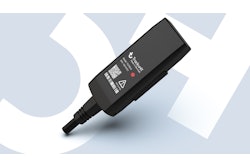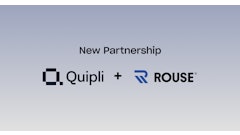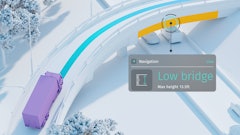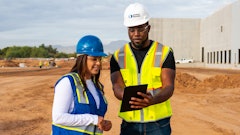
Today, artificial intelligence assistance can be found on almost every platform, from popular internet searches, social media searching, post generation, to educational tools. With the launch of Trackunit's IrisX, the platform places the power of AI in the hands of fleet managers and equipment rental business owners alike.
Rental connected with Trackunit's CEO Søren Brogaard.
Q. What is IrisX?
Any computer system sits on a set of services. For telematics and fleet management, what we have been doing for the better part of 25 years is extracting data from machines, parts, tools, documentation, and third-party data and streaming all that into the cloud. The management, harmonization, or "application intelligence," of the domain-specific information about what that data means all sits in Iris. It's basically a Windows, Mac OS, or iOS.
I'm glad you're asking because that's also what we are super excited about. The tools, applications, and approaches that we've been using internally for the better part of 10 years to develop industrial-tailored applications for rental customers to help with utilization improvements for OEMs to help with improving their parts business and for contractors to improve health and safety. On the upside, all of that is the prerequisite for IrisX.
At Trackunit, we are collecting close to 2 billion data points every single day. Many of our customers are experiencing a massive influx of data. Out of that, many customers are asking themselves, “What is the opportunity of insights? My data is sitting in the tracking system, in our ERP system, or in our part systems - highly isolated. What if we could correlate this different data? What if we could actually build it into a much more integrated approach?”
What we have set out to do is help our customers extend way beyond their current imagination of the capability of the applications they currently have and create the environment and the tools in a secure, well-structured approach that allows them to venture into generative AI; venture into new ways of integrating the data and new ways of talking with the data; new ways of driving insights; and new ways of automating the data. Looking at IrisX as an extended ecosystem, the core touches the OEMs, it touches the rental companies, it touches the contractors, but it also touches a whole set of participants in the ecosystem that are either contributing or benefiting (with proper access, of course) to the data.
IrisX was built for construction with construction. It's a purpose-built operating data platform running in the cloud.
It's not a generic thing that you could get anywhere. It actually has a domain-specific approach. It understands what data means. It has a high real-time performance across both assets, but also sites [such as] a pool of machines on a construction site in a depot.
Tailored Toward IT Professionals
It's very much tailored toward IT professionals, so this is the CFO coming into his team saying, “I need to understand what is the total cost of ownership for running this piece of equipment for the last two years,” “What equipment do I have to sell,” “I need to understand my repair cost on this site or the total jobsite cost of transportation.” These types of questions that are obvious and are fair but require input from many different systems. Today, it's super hard for many organizations to answer these without putting a lot of resources against it.
When we think about data engineering and the use of data at its core, the scalability, the cybersecurity, the privacy, and the trust in the data becomes incredibly important. You don't want to be giving trade secrets out to competitors, so you want to have it proprietary. That's exactly what IrisX has set out to solve.
Around IrisX, you have six core components:
- Analytics and Insights,
- Data Lake,
- Automation Studio,
- AI: Language Models and Generative AI,
- Applications and Extensions, and
- Integrations and Connections.
Analytics and Insight is very much like we know it today. It's a computer algorithm that is looking to answer a question that is predefined. There is a logic and a representation of data that gives you a probability of a certain outcome. It's trying to give you an insight, but it's predefined based on the requester and usually is a piece of code that has been written based on data in one system. You need a workbook. You need code snippets. You need utilities, training, and examples to be super efficient.
The Data Lake is a specific section of IrisX that is just yours. As a customer, this instance is private. This instance is secured and locked down for your use only. This is also where you can start inserting other data streams. For example, your financial data to an asset. This is where you then develop your applications in this workbook and use the Automation Studio to build a workflow. You're literally telling the system to pass this insight into an email string. It could be sending it off 8:00 AM in the morning to a service technician on his phone - you are basically automating the processing and the workflow of the data. Whenever you do that, you need to have strong integrations to third party systems and that's where the Integrations and the Connections comes in.
With IrisX, we are launching more than 1,000 system integrations that are supporting this. A system integration can be a very dangerous thing because it might work on Monday but systems move on, if that integration is not maintained and kept current integrations will break. We are helping customers maintain and secure a proper integration standard with IrisX.
Once you have it integrated and have workflows built, you have your insights. You also want to make sure that you can deploy it and get it out to people as an application. The system offers an application framework where you can either run it in your private browser for internal use, but you can also deploy it on the Trackunit marketplace which gives you the advantage of marketing your application to hundreds of users, contractors, or thousands of other users.
The Trackunit marketplace is open to the public, but you could also be very discreet and unique to who you want to send it to.
Generative AI
Everything stands on the next generation of Generative AI and the large language models where the data is constantly being trained based on your machine data and the data that you insert. A small example could be that the more data you feed into the model (in your private Data Lake), the model becomes smarter.
An example could be that a customer recently uploaded service manuals from five different machines, from five different vendors. The system can then start to understand the context of these service manuals. You can start talking to it like from ChatGPT: "Tell me what the battery is used for on this machine " or "Tell me what it means XY and Z." The generative aspect of IrisX gives us this human interface where you no longer need a programmer to set up every report and analytics inside but I can actually start talking and requesting insights from the data.
Q. I know that chatGPT sometimes gets things wrong. What qualifications have been set in place so that the results are accurate?
You bring up a super-valid point. I think it will take time. Once you build a process, you need people to actually validate that the agent is making the correct rationale and is doing the math consistently correctly. You need to oversee that training. Once you have found the level of quality and stability that you are comfortable with, you can let it go. You can't expect to have a perfect system where you write a question, get a response, and assume it to be 100% correct—technology is simply not that mature yet. You see that with chatGPT, sometimes it returns something that's completely off and the same thing will happen here.
You need time and a bit of patience to help the system get it right. But once you have reached that level, you can sort of let it go on that specific process.
Q. How long was the development of this?
What's interesting is that we've been using these various methods and tools for the better part of six years to build our standard applications that you can buy today off the shelf: Trackunit Manager and its associated applications.
What we've done is turned that entire development suite around and are now giving our customers access to the exact same environment. You could argue that it's been developing and evolving.
In essence, you could say this is the development work of the past six years with more than 100 people. That's a lot of hours and for the past year or so we've been working on encapsulating this into well-structured modules that one can purchase.
Q. What if you're a small independent store that doesn't have an IT-dedicated person? How can this help those smaller business owners?
As we are launching IrisX today, you will need some level of guidance and help. Trackunit or your local IT support that is already providing you with IT infrastructure would also be able to help. Over time as the technology further matures this will become even lighter plug-and-play, but for now it does require a little bit of setup.
I think it's fair to say that once you have set up the environment, the system actually responds with real insights in a very fast way. The data becomes certainly something that you can talk to. You can think about IrisX as your virtual assistant in trying to optimize your fleet.
We are in a world where we see more and more companies working toward these industrial clouds where you're no longer trying to build everything yourself, but standing on platforms and environments that give you speed and are more standardized.
Gartner Research is an IT research house that looks after major trends. Gartner was saying that in the next 10 years, 75% of companies who use systems will start standardizing on industrial-tailored clouds. That's exactly what we are trying to help our customers benefit from. You don't have to interpret the data, we've done that for you. You don't have to set up an environment and figure out how to harmonize the data, we've done that for you. You don't have to figure out how to do generative AI on time series data, we've done that for you.
You can actually start taking advantage of the latest and greatest technology without thinking too much about the underlying infrastructure. We are super excited about that.
Fleet Size
Q. Is there a target fleet range/number of assets that really starts to make IrisX work?
Today, I would say in this early phase of our deployment that you probably want to get beyond 10,000 assets. But our ambition is to take this all the way down to someone who has 10, 15, or 100 assets.
Like all new technology—there's a cost. There's an early adopter cost and, as time progresses and the system becomes more standardized, it flows down. But I don't anticipate that to be a very long period of time—we're not talking years.
Q. Will IrisX come with an amount of information already preloaded?
Yes, because you are already running Iris. If you're tracking the customer, you will already have a really well-populated Iris Data Lake. The prerequisite is already there. When we turn the switch and you get into IrisX, we move all of that over in our IrisX Instance and you can start working with the technology.
Helping Contractors
Q. How will the integrated AI in Iris X help contractors?
I have a great story that developed with a mid-sized contractor in Hong Kong over the past three weeks. They operate across 50 different jobsites [and] rent from five or six different rental shops depending on where in the region the sites are located. They came in as an early adopter and had a very basic question, “Can we save on rental equipment?”
We looked across these 50 jobsites. We looked at when machines arrived on site. Then we looked at when the machine was actually producing an output: somewhere between 12, 18, 24, 36 hours later. We were able to cut the idle time between rent and usage by more than 20%. We could tell them the cost savings and on which jobsites was this opportunity the most real, or where they had the lowest low-hanging fruit.
Q. What security measures are in place?
We have a very strong cybersecurity governance model around our system today where we are not only guaranteeing uptime for reliability and access to data but also a deep, secure interface.
Today, security ranges all the way from making sure that all subsystems are constantly up to date. That they have the newest release and it's tested and validated. There's also the response to cyberthreats and cyberattacks and [what] that response model looks like.
And then there is the security and access around your own private Data Lake, which is also a massive undertaking to make sure that no one else can benefit from your insight, no one else can see your data, it's your proprietary instance. We are being surveyed and tested against both from an ISO point of view but also many of our customers have their own cyber assessment routines that they run against us. We are being put to the test all the time.
What’s Next
Q. What happens with current Trackunit customers when IrisX is actually officially launched?
They can literally just keep going. This is an extension. It's an add-on. It's a new opportunity. They can step into IrisX whenever they feel like it, whenever they have it in the budget cycle, whenever they have the right people, the appetite, or the strategic interest, there's no push.
As long as they keep expanding using the tracking system that they're already on, they are not losing out. They can benefit from IrisX any day they want because it's an extension.
Q. How do you envision this changing the construction and equipment rental industries? How do you envision what these industries will look like in 5, 10, 20 years?
The 50,000 ft. view of this is that it will give productivity improvements—real productivity improvements simply because more people can do more. They get smarter. They get faster. They can deliver more output with the use of these copilots or AI-driven assistants.
Where we are starting to see technology getting to know our habits, getting to know what's on the critical path. They're consuming 10s of thousands of GB of data across many different data silos and they're giving us advice and insights proactively that we would have had to hire 15 people or 20 people or a data scientist to have that same insight. That assistant, that copilot will become very real and become part of any field and office worker’s daily life.
We are already starting to see that in Trackunit, especially in engineering, we are seeing 15 to 20% of the code being generated with AI assistants. It's quite amazing. Also scary for that matter, but it is quite amazing. The productivity across functions in the company is going up 3, 4, 5% every year. If you then move that five or ten years ahead, that's a full-time employee.
Ideally, in a perfect world, you would think that if you are 100 people in your company today, in 10 years, if things keep going as they are, you should be able to get work done as if you were 200 people. That's almost as simple as you can put it.
There was a survey recently that looked across Fortune 500 companies on the threat/opportunity of AI where we see 50% of Fortune 500 companies consider generative AI a threat. Which is scary.
It's a scary thing because you would think that they would see it as an opportunity. I think that's dropped to 25 or 30% because this is actually tough. You can't find the people. When I look across my top 100 customers, they have a massive amount of open positions. They can't simply find the people.
We want to give our customers a step into the age and the generation of AI and generative AI to start taking advantage of these tools without having expertise and deep tech. But, they can step in at a higher abstraction level and start taking advantage and improve their customer experience through better insight, faster responses, secure a line of communication, trust, data, and privacy. These are big words that many people care about because if you don't have privacy and trust in the data, you can't really move forward.





















